RECOMMENDED
Director extraordiniare Larry Raben and choreographer par excellence Lee Martino team up with an all-around fabulous cast to make the very most of book, music, and lyric writer Dean McClure’s World Premiere bio-musical When You Wish (The Story Of Walt Disney), though for producers to dub it a “Pre-Broadway production” is wishful thinking indeed.
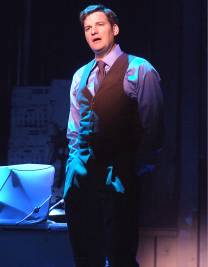 It’s not that Disney’s life from childhood to Anaheim theme park isn’t a fascinating one. It is, and When You Wish’s first act reveals just how many setbacks a constantly in debt Walt had to face on the rocky road to fame and fortune. Also, with the oh-so likeable Tim Martin Gleason standing in for the man whose name has become synonymous with family entertainment, the musical has you rooting for Walt from the get-go.
It’s not that Disney’s life from childhood to Anaheim theme park isn’t a fascinating one. It is, and When You Wish’s first act reveals just how many setbacks a constantly in debt Walt had to face on the rocky road to fame and fortune. Also, with the oh-so likeable Tim Martin Gleason standing in for the man whose name has become synonymous with family entertainment, the musical has you rooting for Walt from the get-go.
Still, as entertaining as When You Wish can be, particularly when its vocally gifted leading players are singing McClure’s catchy, hummable melodies or its sensational dance ensemble make it once again abundantly clear that no one in town choreographs better than Martino, the musical’s second act reveals its greatest drawback. You can’t make Disney’s life into a Broadway-bound musical if you don’t have the rights to Disney’s trademark material.
This becomes especially evident in the superbly choreographed second act “Animation Ballet,” a dance sequence which depicts every Disney animated film from 1940’s Pinocchio to 1955’s Lady And The Tramp without a single note of Disney music or all but the slightest hint of Disney costuming. In fact the only authentic Disney animated material seen in When You Wish are his very earliest cartoons, now in the public domain.
Disney’s early life is a fascinating one, and McClure follows the lovely title tune, sung by Walt’s mother Flora (Melissa Fahn) to Young Walt (Kade Pait), with adult Walt and his earliest staff of animators complaining that there’s “Always A Wolf At The Door,” a leitmotif of Disney’s pre-fame-and-fortune struggle to make ends meet even as he and older brother Roy (Andy Umberger) find themselves increasingly in debt.
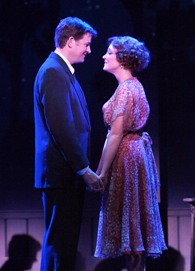 We see both brothers fall in love and marry, Roy to Edna (Fahn again) and Walt to Lillian (Brandi Burkhardt), who charms Walt into proposing, something the shy guy might never have done without her.
We see both brothers fall in love and marry, Roy to Edna (Fahn again) and Walt to Lillian (Brandi Burkhardt), who charms Walt into proposing, something the shy guy might never have done without her.
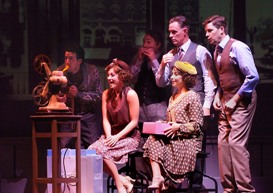 When You Wish makes it amply clear just what a pioneer film maker Walt was: The first to combine animation and live action. The first to film a sound cartoon (Steamboat Willie, though When You Wish makes sure the projection screen’s back is to us, copyright laws not allowing us to see actual clips). The first to make a full-length animated feature (Snow White, though you won’t see any of the movie’s signature characters or costumes or hear any of its now classic tunes). The first to create a theme park the magnitude of Disneyland. And along the way, we learn how “Mortimer” Mouse became Disney’s most famous creation Mickey, whose silhouette in reverse we are apparently allowed to see.
When You Wish makes it amply clear just what a pioneer film maker Walt was: The first to combine animation and live action. The first to film a sound cartoon (Steamboat Willie, though When You Wish makes sure the projection screen’s back is to us, copyright laws not allowing us to see actual clips). The first to make a full-length animated feature (Snow White, though you won’t see any of the movie’s signature characters or costumes or hear any of its now classic tunes). The first to create a theme park the magnitude of Disneyland. And along the way, we learn how “Mortimer” Mouse became Disney’s most famous creation Mickey, whose silhouette in reverse we are apparently allowed to see.
When You Wish is at its most “Broadway” in its full-cast ensemble numbers. “No Limits On Me,” “Just Like The Good Old Days,” and “Mickey Who?” feature catchy upbeat melodies that more importantly showcase Martino’s pizzazzy choreography and as fine a dance ensemble as you’re likely to see any time soon. Ballads like “A Change In Plans” and “Someone In Love” have rather generic lyrics but gorgeous melodies that will stick in your head and make you wish for another listen. Less successful is “I’d Buy Her Diamonds” (“I’d buy her diamonds, I’d buy her pearls”), not only clichéd but entirely the wrong way to end Act One, which needs a great big showstopper like Funny Girl’s “Don’t Rain On My Parade or Hello, Dolly!’s “Before The Parade Passes By” to send audiences out for intermission knowing that, like Fanny Brice and Dolly Levi, Walt Disney ain’t down yet.
The very best reasons to see When You Wish are its absolutely splendid cast and Martino’s show-stopping choreography. (It’s a shame none of the show’s production stills capture any of Martino and company’s fabulous footwork.)
As he proved in last summer’s Sleepless In Seattle The Musical, Gleason is everything you want a hero like Walt Disney to be, and he is every bit the singer as he is the romantic leading man. Leading lady Burkhardt is not only a fine actress, she looks as gorgeous as she sings. Louis Pardo provides terrific support as loyal Disney sidekick animator Ub Iwerks, Fahn is marvelous as always, particularly as Walt’s mom, and Umberger does solid work as Walt’s older brother, though the book’s Roy-as-narrator devise is overused.
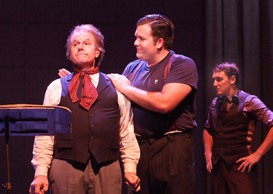 Norman Large steals every scene he’s in as an assortment of comic characters, including a hilariously over-the-top French “Maestro” Carl Edouardo (who simply cannot be bothered with sticking to the beat). Pait and Jake Davidson are young charmers in their brief scenes as the younger Disney brothers.
Norman Large steals every scene he’s in as an assortment of comic characters, including a hilariously over-the-top French “Maestro” Carl Edouardo (who simply cannot be bothered with sticking to the beat). Pait and Jake Davidson are young charmers in their brief scenes as the younger Disney brothers.
The Lee Martino dream team of Jennifer Brasuell, Aurore Joly, Lorenzo King, Morgan Marcell, Salvatore Vassalo, and Louis A. Williams dazzle again and again, especially in the aforementioned “Animation Ballet,” which they make work even without recognizable Disney costumes or tunes.
Katy Harvey, David Michael Laffey, Garrett Marshall, Thomas Adoue Polk, Kirklyn Robinson, and Nick Tubbs not only show off their own dance finesse but do bang-up work playing so many characters that an entire page of the program is taken up listing them.
The very talented Darryl Archibald gets credit for music supervision and dance arrangements, but it’s topnotch conductor/keyboardist David Siebels in the orchestra pit. As for said orchestra, the program seems to imply ten musicians down there though my guess is that there aren’t nearly that many. Also, any strings you might think you hear are entirely synthesized, something that audiences paying around $70 a ticket—once you add in Ticketmaster fees—plus an outrageous $12 UCLA parking may find more than a tad irksome.
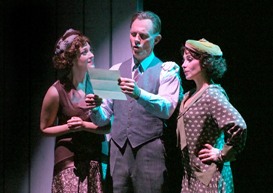 When You Wish producers Pat Boone, McClure, and Rob Rudolph have assembled as elite a design team as any in town. Kate Bergh’s excellent period costumes are the production’s strongest design element, and the designer meriting added snaps for creating outfits that suggest Disney characters without crossing the line into copyright violation. Scenic designer Tom Buderwitz and projection designer Adam Flemming make the most of what was clearly a limited set design budget, Flemming’s projections transforming Buderwitz’s framework into the musical’s multiple locales, a design concept that would be more successful if Tom Ruzika’s otherwise fine lighting design didn’t wash out Flemming’s projected images. Sound designer Philip G. Allen insures that we hear both voices and instruments clearly. John M. McElveney gets top marks for his period properties such as antique projectors and the like.
When You Wish producers Pat Boone, McClure, and Rob Rudolph have assembled as elite a design team as any in town. Kate Bergh’s excellent period costumes are the production’s strongest design element, and the designer meriting added snaps for creating outfits that suggest Disney characters without crossing the line into copyright violation. Scenic designer Tom Buderwitz and projection designer Adam Flemming make the most of what was clearly a limited set design budget, Flemming’s projections transforming Buderwitz’s framework into the musical’s multiple locales, a design concept that would be more successful if Tom Ruzika’s otherwise fine lighting design didn’t wash out Flemming’s projected images. Sound designer Philip G. Allen insures that we hear both voices and instruments clearly. John M. McElveney gets top marks for his period properties such as antique projectors and the like.
John W. Calder III is production stage manager and Cate Cundiff assistant stage manager. Casting is by Michael Donovan Casting, Michael Donovan, CSA, and Peter Matyas, CSA.
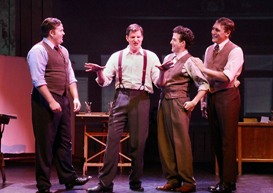 When You Wish feels more like a 1950s-era musical than a contemporary Broadway show. (Kinky Boots, Newsies, The Book Of Mormon, Sister Act, Next To Normal, or Shrek The Musical it is not.) That, combined with copyright restrictions that tie its creative team’s hands, make it an unlikely candidate for bigger and better things post its current engagement. Still, with Raben, Martino, and cast doing their darnedest to make the very best of When You Wish, audiences who spend an evening with Walt and company will find themselves entertained, if not quite getting their money’s worth.
When You Wish feels more like a 1950s-era musical than a contemporary Broadway show. (Kinky Boots, Newsies, The Book Of Mormon, Sister Act, Next To Normal, or Shrek The Musical it is not.) That, combined with copyright restrictions that tie its creative team’s hands, make it an unlikely candidate for bigger and better things post its current engagement. Still, with Raben, Martino, and cast doing their darnedest to make the very best of When You Wish, audiences who spend an evening with Walt and company will find themselves entertained, if not quite getting their money’s worth.
Theatre: Freud Playhouse, UCLA, 405 Hilgard Avenue, Los Angeles.
www.whenyouwishmusical.com
–Steven Stanley
October 23, 2013
Photos: Ed Krieger
Tags: Larry Raben, Lee Martino, Los Angeles Theater Review, Walt Disney


 Since 2007, Steven Stanley's StageSceneLA.com has spotlighted the best in Southern California theater via reviews, interviews, and its annual StageSceneLA Scenies.
Since 2007, Steven Stanley's StageSceneLA.com has spotlighted the best in Southern California theater via reviews, interviews, and its annual StageSceneLA Scenies.







 COPYRIGHT 2025 STEVEN STANLEY :: DESIGN BY
COPYRIGHT 2025 STEVEN STANLEY :: DESIGN BY